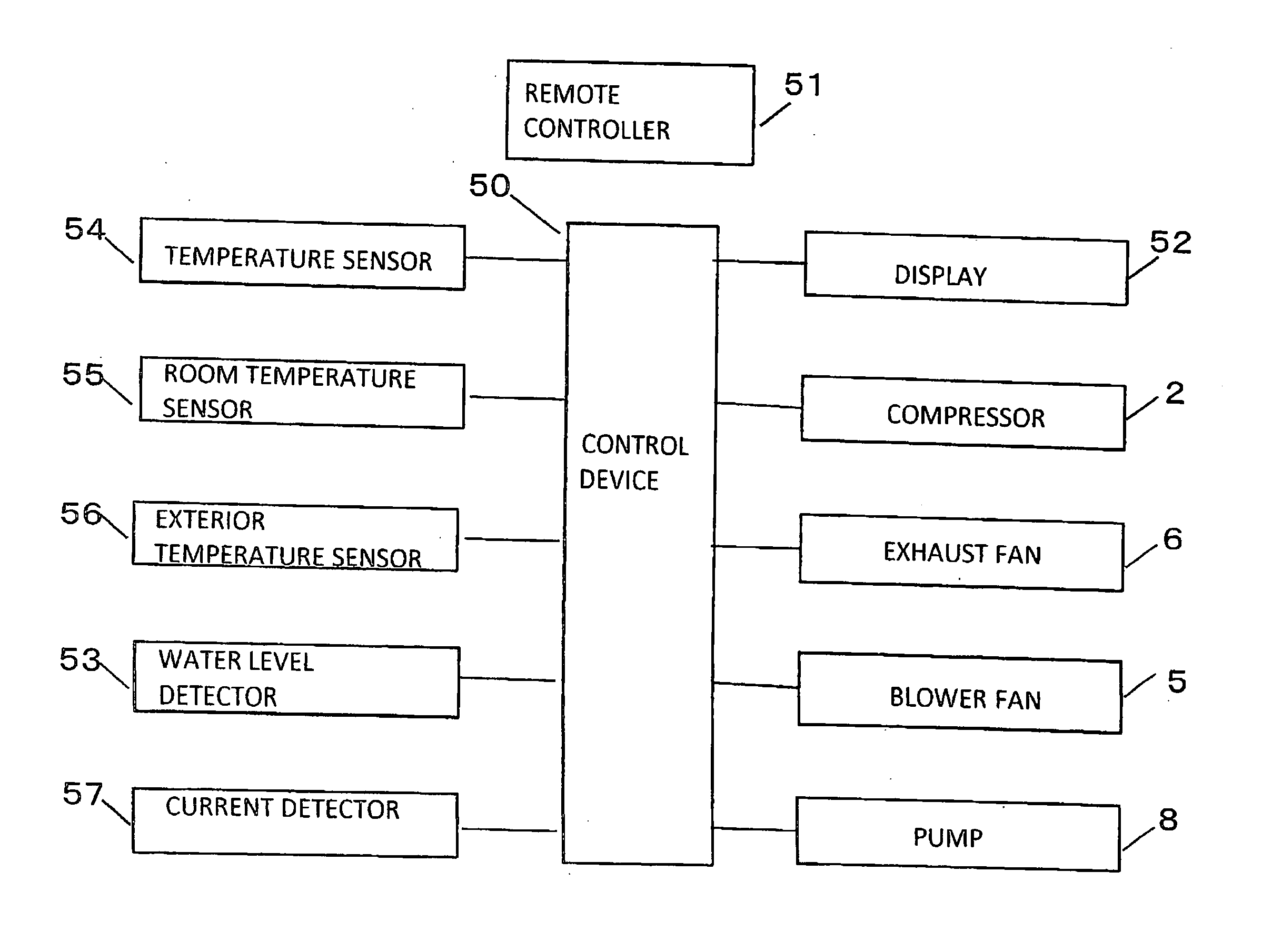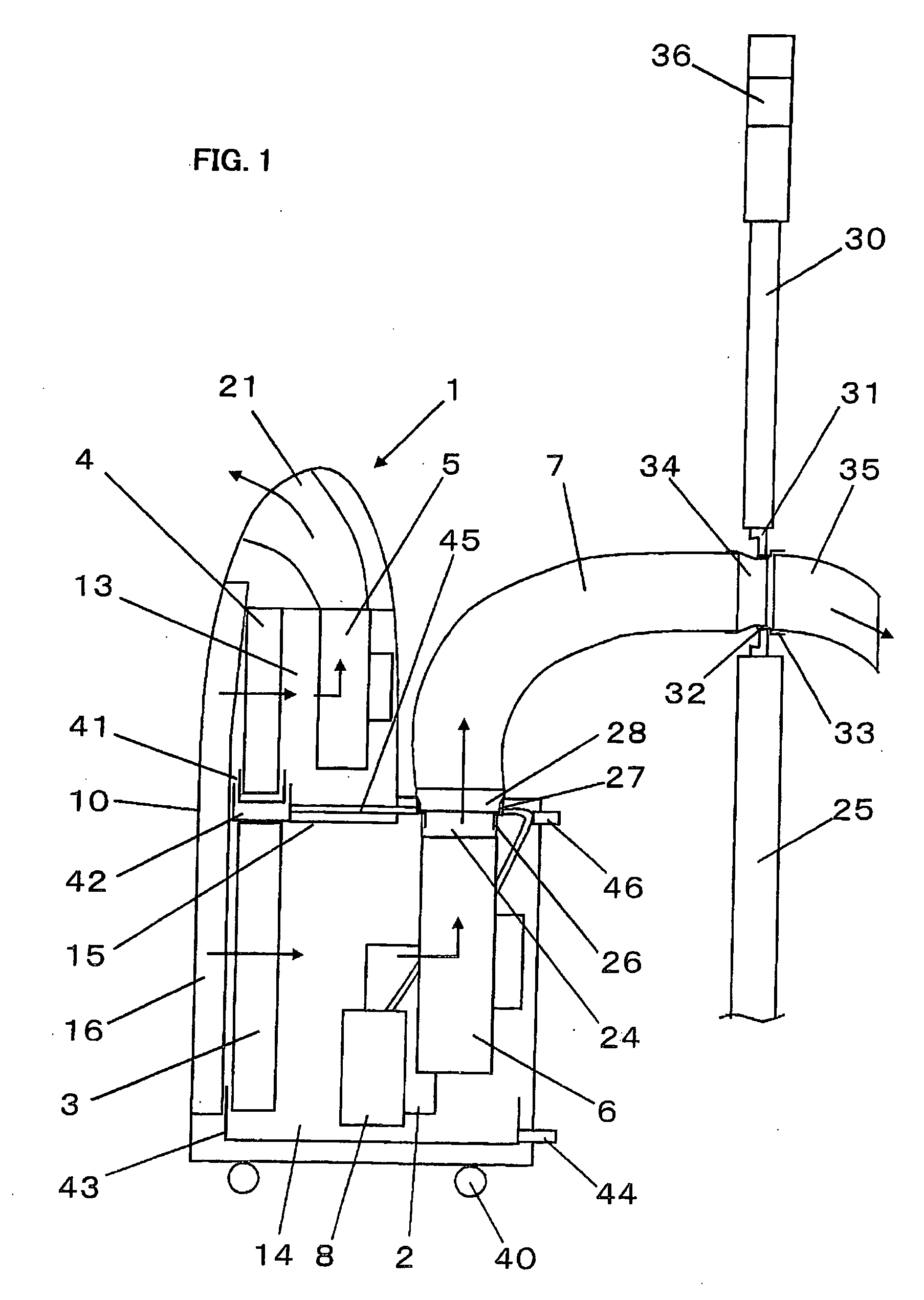Integral type air conditioner
a technology of integrated air conditioner and air conditioner, which is applied in the direction of dynamo-electric motor/converter starter, refrigeration components, field or armature current control, etc., can solve problems such as overcurrent, and achieve the effects of increasing the rotational number of the exhaust fan, and reducing the rotational number of the blower fan
- Summary
- Abstract
- Description
- Claims
- Application Information
AI Technical Summary
Benefits of technology
Problems solved by technology
Method used
Image
Examples
first embodiment
[0051]In the control, the control device 50 controls rotation of the blowing fan based on the detected operating current. That is, the control device 50 reduces the rotational number of the blower fan 5, when the detected operating current exceeds a reference value during operation.
[0052]When operation is started, the control device 50 determines the initial rotational number of the blower fan 5 and the exhaust fan 6 based on a room temperature. The initial rotational number is set, for example, at 500 rpm. During operation, the current detector 57 detects the operating current. As shown in FIG. 6, when the operating current exceeds a reference value, for example, 15 A, the control device 50 controls the blower fan 5 to reduce the rotational number of the blower fan 5. The rotational number of the blower fan 5 is reduced at a fixed rate. For example, the number is lowered at a rate of 10 rotations per second. Meanwhile, the rotational number of the exhaust fan 6 is not changed.
[0053...
second embodiment
[0063]In the above-described embodiment, when the operating current exceeds the reference value, the rotation of each of the fans 5 and 6 is controlled regardless of a current value. In a second embodiment, the rotation of the blower fan 5 and the exhaust fan 6 is controlled depending on the current value. When the operating current exceeds the reference value, the control device 50 controls the rotation of the exhaust fan 6 and the blower fan 5 in a stepwise manner in accordance with change in the operation current.
[0064]As shown in FIG. 7, a plurality of reference values are set depending on the current value. The reference value has hysteresis, and the reference value when the operating current changes to increase is different from that when the operating current changes to decrease. The former reference value is set higher than the latter reference value. The control device 50 reduces the rotational number of the blower fan 5, or increases the rotational number of the exhaust fa...
third embodiment
[0076]Meanwhile, load variation in the compressor 2 is likely to occur right after the start of operation when the operation is not stable yet. Hence, as a third embodiment, in accordance with an operation time, a reference value of the operating current is changed. The control device 50 controls the rotation of the blower fan 5 and the exhaust fan 6 based on a first reference value until a fixed time has elapsed from start of operation, and controls the rotation of the blower fan 5 and the exhaust fan 6 based on a second reference value after the fixed time has elapsed. The first reference value is lower than the second reference value.
[0077]Upon start of cooling operation or dehumidifying operation, the blower fan 5 and the exhaust fan 6 are driven at the initial rotational number (500 rpm). The control device 50 decreases the rotational number of the blower fan 5 based on the first and the second reference values. The rotational number of the exhaust fan 6 is fixed. As shown in F...
PUM
 Login to View More
Login to View More Abstract
Description
Claims
Application Information
 Login to View More
Login to View More - R&D
- Intellectual Property
- Life Sciences
- Materials
- Tech Scout
- Unparalleled Data Quality
- Higher Quality Content
- 60% Fewer Hallucinations
Browse by: Latest US Patents, China's latest patents, Technical Efficacy Thesaurus, Application Domain, Technology Topic, Popular Technical Reports.
© 2025 PatSnap. All rights reserved.Legal|Privacy policy|Modern Slavery Act Transparency Statement|Sitemap|About US| Contact US: help@patsnap.com



